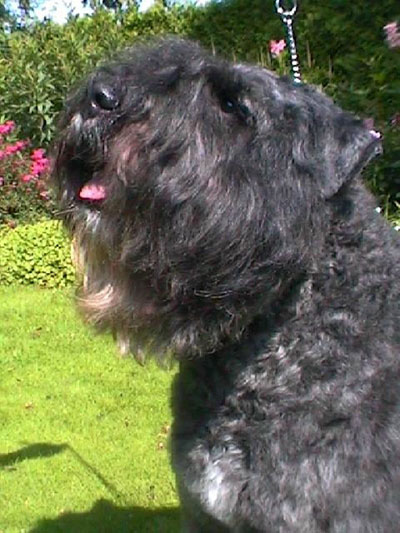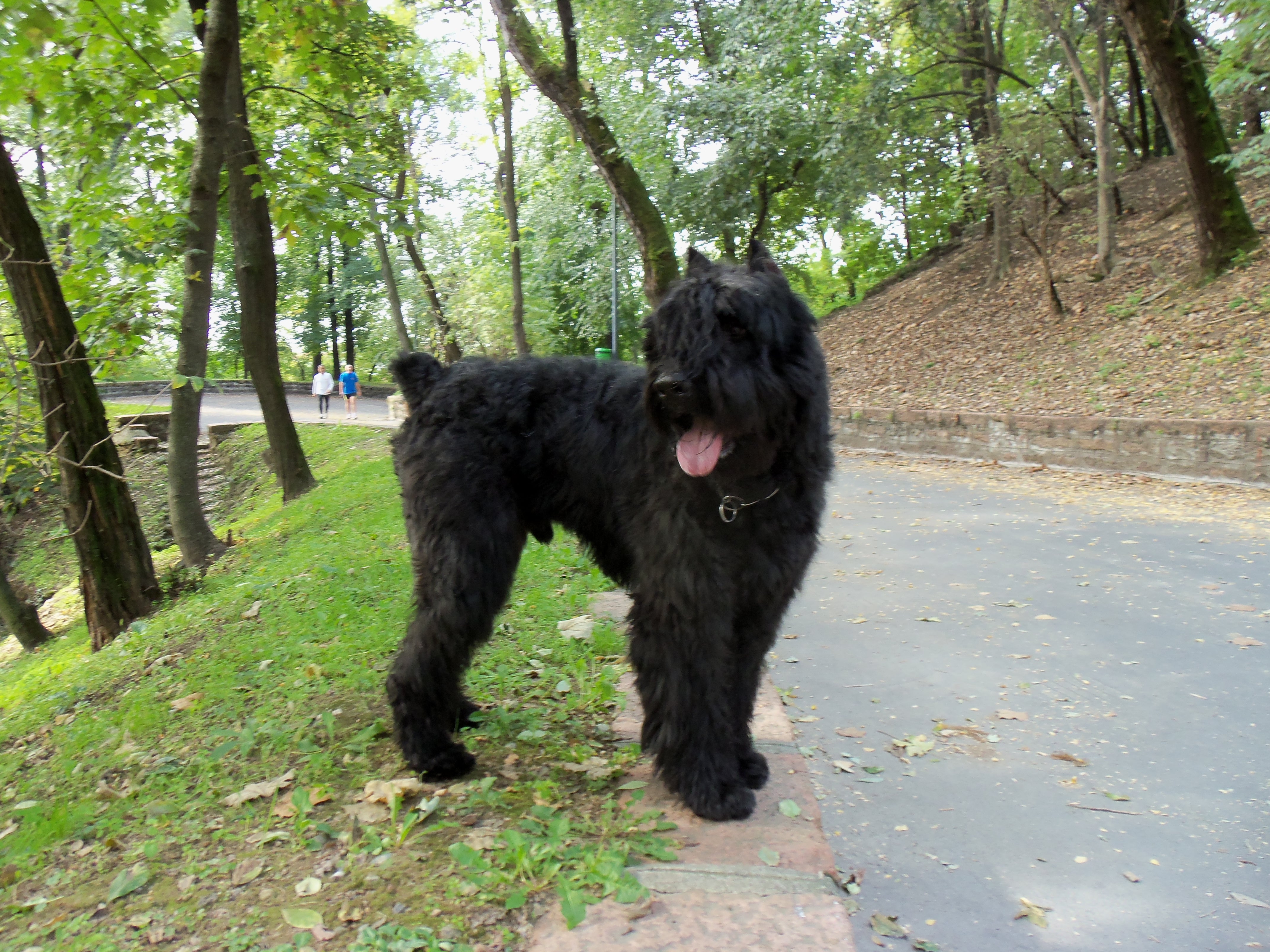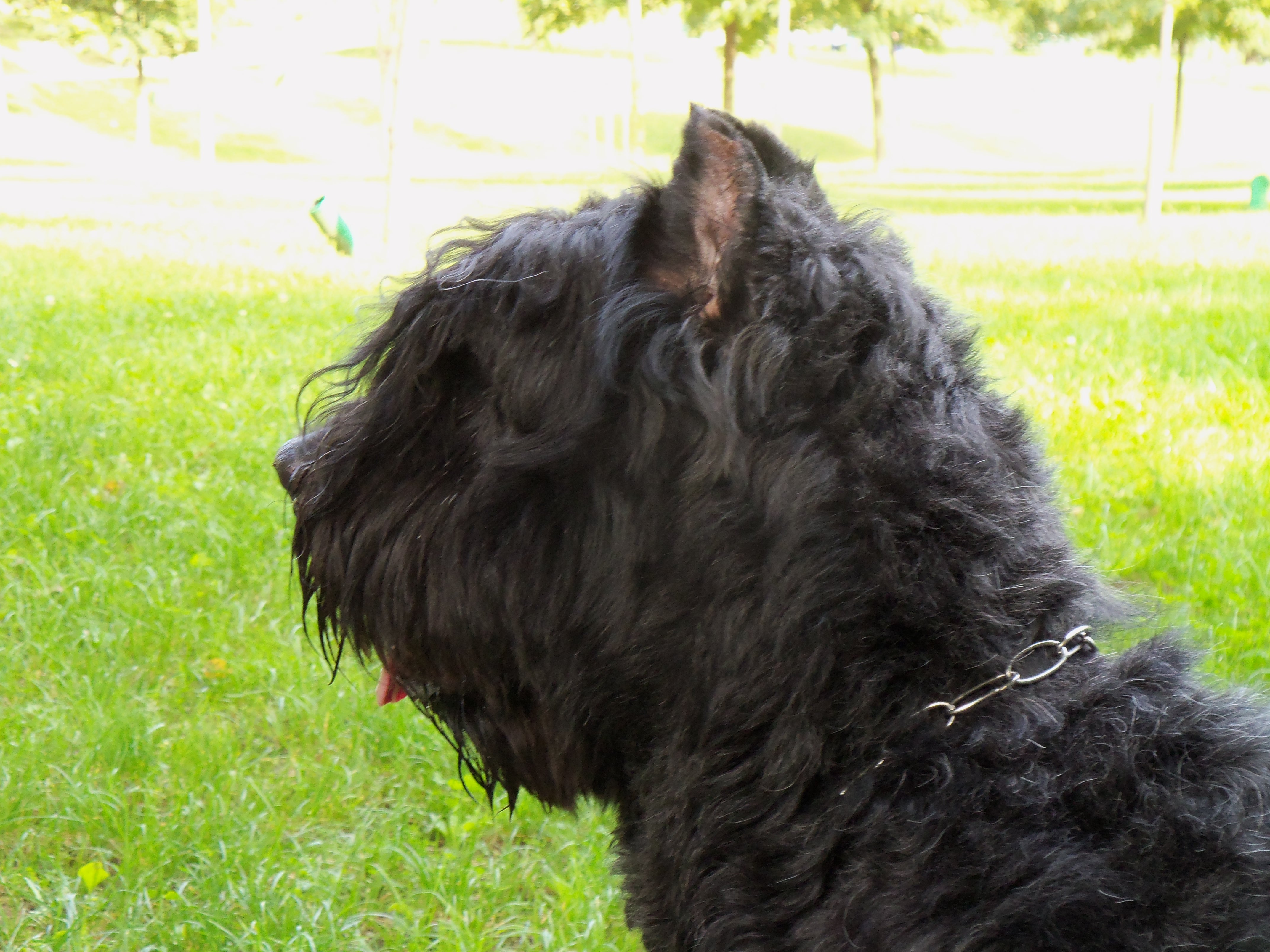Bouvier Des Flandres on:
[Wikipedia]
[Google]
[Amazon]
The Bouvier des Flandres is a
 The monks at the Ter Duinen monastery were among the earliest known dog breeders in Flanders. The bouviers bred by them are recorded as having been bred from imports such as Irish wolfhounds and
The monks at the Ter Duinen monastery were among the earliest known dog breeders in Flanders. The bouviers bred by them are recorded as having been bred from imports such as Irish wolfhounds and  Up until the early 20th century, the breed was not completely defined, with three variants: Paret, Moerman or Roeselare, and
Up until the early 20th century, the breed was not completely defined, with three variants: Paret, Moerman or Roeselare, and


 Bouviers des Flandres are rational, gentle, loyal, and protective by nature. The breed's particular blend of characteristics makes them good family pets, as well as keen guard dogs. Unlike some animals bred for aggressive nature and power, the Bouvier possesses sophisticated traits, such as complex control, intelligence, and accountability.
The Bouvier des Flandres is an obedient dog with a pleasant nature. They look intimidating, but are actually calm and gentle. They are enthusiastic, responsible, even-tempered, and fearless, and are excellent guard and watchdogs that are easy to train. This breed learns commands relatively fast. However, Bouviers get bored easily and learn best when repetition is limited.
They require well-balanced training that remains consistent in nature. Without being harsh, it is important to consistently make the dog aware that the owner will remain the boss. This breed needs an experienced owner to prevent dominance and over-protectiveness problems. These dogs poorly trained can become inappropriately dominant towards humans. An un-socialized Bouvier can become fearful and pose a problem when introduced to new situations in which they do not feel comfortable.
Bouviers should be socialized well, preferably starting at an early age, to avoid shyness, suspiciousness, and being overly reserved with strangers (although the breed is naturally aloof with strangers). Protection of the family when danger is present is not something that needs to be taught, nor is it something one can train out of them. The dog will rise to the occasion if needed. A good family dog, the Bouvier likes, and is excellent with, children. The Bouvier is very adaptable and goes about its business quietly and calmly. Obedience training starts when they are young. Their behavior depends on the owner's ability to communicate what is expected, and on the individual dominance level of the dog. They are usually good with other dogs if they are raised with them from puppyhood. Dominant individuals can be dog-aggressive if the owners are not assertive and do not communicate to the dog that fighting is unwanted. Slow to mature both in body and mind, the Bouvier does not fully mature until the age of 2–3 years.
Bouviers des Flandres are rational, gentle, loyal, and protective by nature. The breed's particular blend of characteristics makes them good family pets, as well as keen guard dogs. Unlike some animals bred for aggressive nature and power, the Bouvier possesses sophisticated traits, such as complex control, intelligence, and accountability.
The Bouvier des Flandres is an obedient dog with a pleasant nature. They look intimidating, but are actually calm and gentle. They are enthusiastic, responsible, even-tempered, and fearless, and are excellent guard and watchdogs that are easy to train. This breed learns commands relatively fast. However, Bouviers get bored easily and learn best when repetition is limited.
They require well-balanced training that remains consistent in nature. Without being harsh, it is important to consistently make the dog aware that the owner will remain the boss. This breed needs an experienced owner to prevent dominance and over-protectiveness problems. These dogs poorly trained can become inappropriately dominant towards humans. An un-socialized Bouvier can become fearful and pose a problem when introduced to new situations in which they do not feel comfortable.
Bouviers should be socialized well, preferably starting at an early age, to avoid shyness, suspiciousness, and being overly reserved with strangers (although the breed is naturally aloof with strangers). Protection of the family when danger is present is not something that needs to be taught, nor is it something one can train out of them. The dog will rise to the occasion if needed. A good family dog, the Bouvier likes, and is excellent with, children. The Bouvier is very adaptable and goes about its business quietly and calmly. Obedience training starts when they are young. Their behavior depends on the owner's ability to communicate what is expected, and on the individual dominance level of the dog. They are usually good with other dogs if they are raised with them from puppyhood. Dominant individuals can be dog-aggressive if the owners are not assertive and do not communicate to the dog that fighting is unwanted. Slow to mature both in body and mind, the Bouvier does not fully mature until the age of 2–3 years.
 * Belco, the dog that accompanied Edmee Bowles to America when she fled occupied
* Belco, the dog that accompanied Edmee Bowles to America when she fled occupied
herding dog
A herding dog, also known as a stock dog, shepherd dog, sheep dog or working dog, is a Dog type, type of dog that either has been trained in herding or belongs to dog breed, breeds that are developed for herding.
Herding behavior
All herd ...
breed
A breed is a specific group of domestic animals having homogeneous appearance (phenotype), homogeneous behavior, and/or other characteristics that distinguish it from other organisms of the same species. In literature, there exist several slig ...
originating in Flanders
Flanders (, ; Dutch: ''Vlaanderen'' ) is the Flemish-speaking northern portion of Belgium and one of the communities, regions and language areas of Belgium. However, there are several overlapping definitions, including ones related to culture, ...
, Belgium
Belgium, ; french: Belgique ; german: Belgien officially the Kingdom of Belgium, is a country in Northwestern Europe. The country is bordered by the Netherlands to the north, Germany to the east, Luxembourg to the southeast, France to th ...
. They were originally used for general farm
A farm (also called an agricultural holding) is an area of land that is devoted primarily to agricultural processes with the primary objective of producing food and other crops; it is the basic facility in food production. The name is used fo ...
work including cattle
Cattle (''Bos taurus'') are large, domesticated, cloven-hooved, herbivores. They are a prominent modern member of the subfamily Bovinae and the most widespread species of the genus ''Bos''. Adult females are referred to as cows and adult mal ...
droving
Droving is the practice of walking livestock over long distances. It is a type of herding. Droving stock to market—usually on foot and often with the aid of dogs—has a very long history in the Old World. An owner might entrust an agent to deli ...
, sheep herding, and cart pulling, and nowadays as guard dog
A guard dog or watchdog (not to be confused with an attack dog) is a dog used to watch for and guard property against unwanted or unexpected human or animal intruders.
The dog is discerning so that it does not annoy or attack the resident hum ...
s and police dogs, as well as being kept as pets. The French name of the breed means, literally, "Cow Herder of Flanders", referring to the Flemish origin of the breed. Other names for the breed are ''Toucheur de Boeuf'' (cattle driver), ''Vlaamse Koehond'' (Flemish cow dog), and ''Vuilbaard'' (dirty beard).
History
 The monks at the Ter Duinen monastery were among the earliest known dog breeders in Flanders. The bouviers bred by them are recorded as having been bred from imports such as Irish wolfhounds and
The monks at the Ter Duinen monastery were among the earliest known dog breeders in Flanders. The bouviers bred by them are recorded as having been bred from imports such as Irish wolfhounds and Scottish deerhound
The Scottish Deerhound, or simply the Deerhound, is a large breed of sighthound, once bred to hunt the red deer by coursing. In outward appearance, the Scottish Deerhound is similar to the Greyhound, but larger and more heavily boned with a rough-c ...
s with local farm dogs, until a breed considered to be the predecessor of the modern Bouvier des Flandres was obtained. This became a working dog able to perform tirelessly, herding and guarding cattle and even pulling cargo carts, thanks to its strength and temperament, and to withstand the local weather conditions due to its thick coat.Pollet, Robert (2003). ''Bouvier Des Flandres''. Editorial Hispano-Europea. The breed's practical use became antiquated after the invention of the automobile, when cattle were more practically transported by trucks.
Historically, the ear cropping and tail docking could have been done for practical reasons, avoiding accidental amputations in the course of work, or to indicate the dog was working stock and not a pet subject to taxation.
 Up until the early 20th century, the breed was not completely defined, with three variants: Paret, Moerman or Roeselare, and
Up until the early 20th century, the breed was not completely defined, with three variants: Paret, Moerman or Roeselare, and Briard
The Briard or is a French breed of large shepherd dog, traditionally used both for herding sheep and to defend them. It was first shown at the first Paris dog show, in 1863; the first Briard to be registered in the ''Livre des Origines Franç ...
. Conflict between the proponents of these three variants held the breed's development back. In 1912 and 1913, several local kennel clubs recognized standards for Bouviers; however they usually had different standards for the Roeselare and other variants.
World War I
World War I (28 July 1914 11 November 1918), often abbreviated as WWI, was one of the deadliest global conflicts in history. Belligerents included much of Europe, the Russian Empire, the United States, and the Ottoman Empire, with fightin ...
nearly caused the breed to disappear, due to the devastation that came over its region of origin and the fact that the dogs were used for military purposes. Indeed, Nic, a male trained as a trench dog who served during the war and was a perennial winner at dog shows after the war, is considered to be the founder of the early Bouvier des Flandres breed.
A unified Bouvier des Flandres standard was created in 1936 by a joint French-Belgian committee. However, World War II
World War II or the Second World War, often abbreviated as WWII or WW2, was a world war that lasted from 1939 to 1945. It involved the vast majority of the world's countries—including all of the great powers—forming two opposin ...
again endangered the breed's existence. Due to these setbacks, progress was slowed, and it was not until 1965 that the ''Fédération Cynologique Internationale
The Fédération cynologique internationale (FCI) (English: International Canine Federation) is the largest international federation of national kennel clubs. It is based in Thuin, Belgium.
History
The FCI was founded in 1911 under the auspices ...
'' (FCI) breed standard, as agreed to by several minor kennel clubs, was adopted.
Description

Appearance
The Bouvier is a powerfully built, compact, rough-coated dog of rugged appearance. It gives the impression of size and strength without clumsiness or heaviness. Perhaps its most notable feature is the impressive head which is accentuated by a heavy beard and mustache. Although the practice of cropping both ears and tail are now mostly cosmetic, tails were originally docked to prevent injuries caused by herding and cart-pulling. The practice of cosmetic docking is currently opposed by theAmerican Veterinary Medical Association
The American Veterinary Medical Association (AVMA), founded in 1863, is a not-for-profit association representing more than 99,500 veterinarians in the US.
The AVMA provides information resources, continuing education opportunities, publicatio ...
. In the area of origin (Flanders, Belgium) cropping was made illegal in 2006. The weight of males ranges from 80 to 120 pounds or 36 to 54 kilograms, slightly smaller for females. They are powerfully built, with a thick double coat
The coat of the domestic dog refers to the hair that covers its body. Dogs demonstrate a wide range of coat colors, patterns, textures, and lengths.
As with other mammals, a dog's fur has many uses, including thermoregulation and protection fr ...
, which can be fawn, black, grey brindle, or "pepper and salt" in color. Bouviers are sometimes considered non-shedding, but in fact do lose hair, like all dogs. Most of the hair that they lose is caught within the double coat which results in matting. They require weekly brushing and combing to maintain the coat. In addition to weekly brushing, the coat should be trimmed approximately every 3–5 weeks if it is to be a show dog. Trimming requires practice to achieve the proper look.
Temperament
Activities
Bouviers des Flandres can compete indog agility
Dog agility is a dog sport in which a handler directs a dog through an obstacle course in a race for both time and accuracy. Dogs run off leash with no food or toys as incentives, and the handler can touch neither dog nor obstacles. The handler ...
trials, carting
Carting is a dog sport or activity in which a dog (usually a large breed) pulls a dogcart filled with supplies, such as farm goods, camping equipment, groceries or firewood, but sometimes pulling people. Carting as a sport is also known as dry ...
, obedience, dog showmanship
Dog showmanship is a set of skills and etiquette used by handlers of dogs in a dog competition. Dog showmanship is not a competition in itself but a qualification of the handler to present a dog to its best advantage. Skills are technical as well a ...
, Schutzhund
Schutzhund (/'ʃʊtshʊnt/, German for "protection dog"), currently known competitively as IGP and previously as IPO, is a dog sport that tests a dog's tracking, obedience, and protection skills, and evaluates if a dog has the appropriate tr ...
, tracking
Tracking may refer to:
Science and technology Computing
* Tracking, in computer graphics, in match moving (insertion of graphics into footage)
* Tracking, composing music with music tracker software
* Eye tracking, measuring the position of t ...
, and herding
Herding is the act of bringing individual animals together into a group (herd), maintaining the group, and moving the group from place to place—or any combination of those. Herding can refer either to the process of animals forming herds in ...
events. Herding instincts and trainability can be measured at noncompetitive herding tests. Bouviers exhibiting basic herding instincts can then be trained to compete in herding trials.
Notable Bouviers des Flandres
Belgium
Belgium, ; french: Belgique ; german: Belgien officially the Kingdom of Belgium, is a country in Northwestern Europe. The country is bordered by the Netherlands to the north, Germany to the east, Luxembourg to the southeast, France to th ...
and who was the foundation stud of her kennel Clos du Cereberes at Belco Farm in Pennsylvania
Pennsylvania (; ( Pennsylvania Dutch: )), officially the Commonwealth of Pennsylvania, is a state spanning the Mid-Atlantic, Northeastern, Appalachian, and Great Lakes regions of the United States. It borders Delaware to its southeast, ...
.
* Soprano de la Thudinie, the post-war foundation stud of Justin Chastel's de la Thudinie kennel in Belgium and the most prominent ancestor of the modern type of Bouvier des Flandres.
* Lucky, owned by United States President Ronald Reagan
Ronald Wilson Reagan ( ; February 6, 1911June 5, 2004) was an American politician, actor, and union leader who served as the 40th president of the United States from 1981 to 1989. He also served as the 33rd governor of California from 1967 ...
and First Lady Nancy Reagan
Nancy Davis Reagan (; born Anne Frances Robbins; July 6, 1921 – March 6, 2016) was an American film actress and First Lady of the United States from 1981 to 1989. She was the second wife of president Ronald Reagan.
Reagan was born in N ...
.
* Patrasche, the dog found by a boy named Nello in '' A Dog of Flanders'', is often asserted to be a Bouvier des Flandres.
* Max and his mate Madchen and their puppies, fictional characters featured in W.E.B. Griffin
William Edmund Butterworth III (November 10, 1929 – February 12, 2019), better known by his pen name W. E. B. Griffin, was an American writer of military and detective fiction with 59 novels in seven series published under that name. Twenty-one ...
's ''Presidential Agent'' series.
*Isabelle du Monceau de Bergendal, a character within the Strike Witches
is a Japanese media mix originally created by Fumikane Shimada via a series of magazine illustration columns. The franchise has since been adapted into several light novel, manga, and anime series and various video games. ...
series, has a Bouvier des Flandres as her familiar animal.
*Gretel, a Bouvier des Flandres, is the dog of Dr. Robert Romano on '' ER''.
*Kirie, a young female Bouvier, is owned by criminal police officer Gereon Rath, the protagonist of Volker Kutscher's series of detective novels set in the 1930s Berlin. Originally belonging to a murdered Belgian actress, Kirie is adopted by Rath in '' The Silent Death '', the second novel in the series, and remains his companion until her death in '' Olympia'', the eight installment.
See also
* Dogs portal *List of dog breeds
This list of dog breeds includes both Neontology#Extant taxa versus extinct taxa, extant and extinct dog breeds, Designer breed, varieties, landraces, and dog types. A research article on genomics, dog genomics published in Science/AAAS defines m ...
References
External links
* {{DEFAULTSORT:Bouvier Des Flandres FCI breeds Herding dogs Dog breeds originating in Belgium